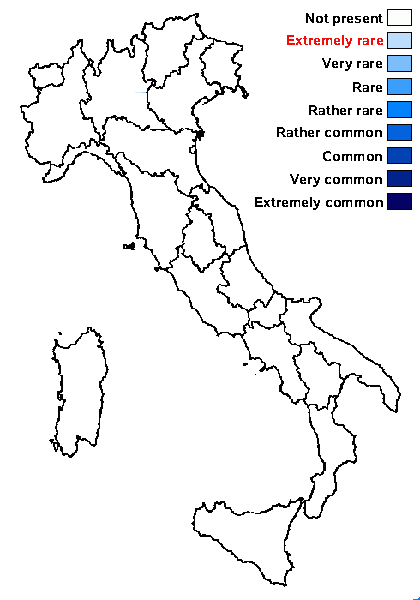Collemopsidium subarenisedum (G. Salisb.) Coppins & Aptroot
Lichenologist, 40: 368, 2008. Basionym: Arthopyrenia subareniseda G. Salisb, - Naturalist, Hull: 17, 1953
Synonyms:
Distribution:
Description: Thallus crustose, endosubstratic and usually not evident, sometimes appearing as a grey patch. Perithecia scattered, black, 0.08-0.2 mm in diam., semi-immersed, globose. Involucrellum absent; exciple dark, more or less cellular; hamathecium of richly branched and anastomosing, 1.5-2 µm thick pseudoparaphyses, the hymenial gel I-. Asci 8-spored, ovoid to subcylindrical, usually stalked, with two functional wall layers, K/I-, the wall thickened above, with an ocular chamber, fissitunicate, with a distinct extruded rostrum at dehiscence, 70-100 x 13-14 µm. Ascospores 1-septate, hyaline, ovoid to ovoid-fusiform, 15-19(-21) x 5-7 µm, often with a thin gelatinous sheath. Photobiont cyanobacterial (Hyella, the cells orange, in scattered clusters). Spot tests: all negative. Chemistry: without lichen substances.Note: a pioneer, rather ephemeral species growing on sandy soil between dunes; known from the British Isles, Spain, Netherlands and Germany. To be looked for in Italy.
Growth form: Crustose
Substrata: soil, terricolous mosses, and plant debris
Photobiont: cyanobacteria, filamentous (e.g. Nostoc, Scytonema)
Reproductive strategy: mainly sexual
Most common in areas with a humid-warm climate (e.g. most of Tyrrenian Italy)
Pioneer species

Predictive model
Growth form: Crustose
Substrata: soil, terricolous mosses, and plant debris
Photobiont: cyanobacteria, filamentous (e.g. Nostoc, Scytonema)
Reproductive strategy: mainly sexual
Most common in areas with a humid-warm climate (e.g. most of Tyrrenian Italy)
Pioneer species

Predictive model
 Index Fungorum
Index Fungorum
 GBIF
GBIF

